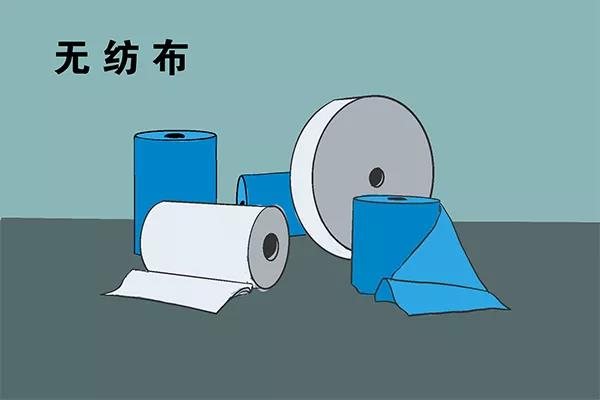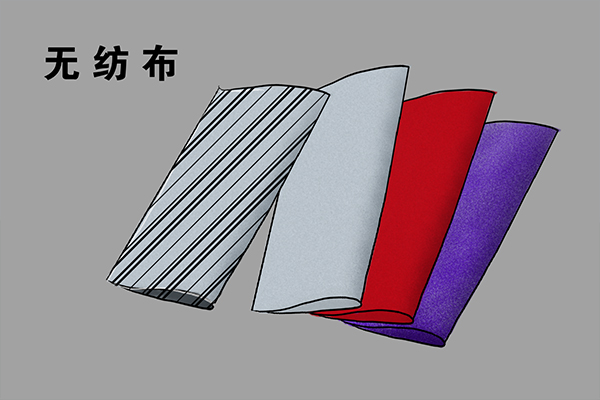In public perception, traditional fabrics are woven. The name of the non-woven fabric is confusing, does it really need to be woven?

Non-woven fabrics are also called non-woven fabrics, which are fabrics that do not need to be woven or woven. It is not traditionally made by interweaving and knitting yarns one by one, but a cloth formed by directly bonding fibers together through physical methods. In terms of production process, non-woven fabrics directly use polymer chips, short fibers or filaments to form fibers through airflow or mechanical netting, and then strengthen by spunlacing, needle punching or hot rolling, and finally form a non-woven fabric after finishing Of fabric.
The production process of non-woven fabrics can be divided into the following steps:
1. Combing the fiber; 2. Fiber into a net; 3. Fixing of the fiber net; 4. Perform heat treatment; 5. Finally, finishing and processing.
According to the causes of non-woven fabrics, it can be classified as:
Spunlace non-woven fabrics: High-pressure fine water jets are sprayed onto one or more layers of fiber webs to entangle the fibers with each other, thereby strengthening the fiber webs.
Heat-bonding non-woven fabric: adding fibrous or powdery hot-melt bonding reinforcement material to the fiber web, so that the fiber web is heated and melted and then cooled to reinforce it into a cloth.
Pulp air-laid non-woven fabric: also known as dust-free paper, dry paper-making non-woven fabric. It uses air-laid technology to convert wood pulp fibers into single fibers, and air-laid fibers are used to agglomerate the fibers on the web curtain and then reinforce into a cloth.
Wet-laid non-woven fabric: The fiber raw materials placed in the water medium are opened into single fibers, and different fiber raw materials are mixed to form a fiber suspension slurry, which is transported to the web forming mechanism, and the web is consolidated into a cloth in a wet state.
Spunbond non-woven fabric: After the polymer is extruded and stretched to form continuous filaments, it is laid into a net, and the fiber net is bonded or mechanically reinforced to become a non-woven fabric.
Meltblown non-woven fabric: The production steps are polymer input-melt extrusion-fiber formation-fiber cooling-net formation-reinforcement into cloth.
Needle-punched non-woven fabric: It is a kind of dry-laid non-woven fabric, which uses the piercing effect of needles to reinforce the fluffy web into a cloth.
Stitched non-woven fabric: It is a kind of dry-laid non-woven fabric, which uses warp-knitted loop structure to reinforce fiber web, yarn layer, non-woven material (such as plastic sheet, etc.) or their combination to make non-woven fabric .
The fiber raw materials required to make non-woven fabrics are very wide, such as cotton, hemp, wool, asbestos, glass fiber, viscose fiber (rayon) and synthetic fiber (including nylon, polyester, acrylic, polyvinyl chloride, vinylon) Wait). But nowadays, non-woven fabrics are no longer mainly made of cotton fibers, and other fibers such as rayon have taken their place.

Non-woven fabric is also a new type of environmentally friendly material, which has the characteristics of moisture-proof, breathable, elastic, light weight, non-combustible, easy to decompose, non-toxic and non-irritating, rich in color, low price, recyclable, etc., so the application field Very extensive.
Among industrial materials, non-woven fabrics have the characteristics of high filtration efficiency, insulation, heat insulation, acid resistance, alkali resistance, and tear resistance. They are mostly used to make filter media, sound insulation, electrical insulation, packaging, roofing and abrasive materials, etc. product. In the daily necessities industry, it can be used as clothing lining materials, curtains, wall decoration materials, diapers, travel bags, etc. In medical and health products, it can be used in the production of surgical gowns, patient gowns, masks, sanitary belts, etc.
Post time: Apr-13-2021
